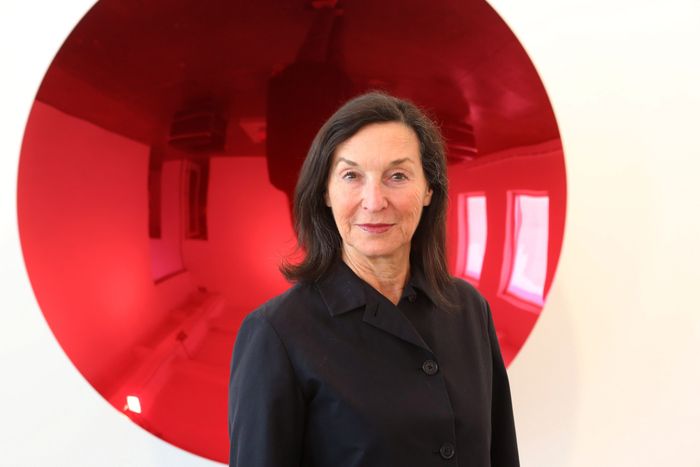
Barbara Gladstone, who died on Sunday at the age of 89, was a gallerist in extreme. Fierce, funny, and radiating intensity, she seemed never to sit still, rarely admitted she was wrong, and was perpetually readying her next move. She was a formidable advocate for her artists, but she wore the power of her influence lightly, like a necklace. Gaggles of critics, curators, and museum people materialized wherever she went. To me, she was a friend — later an estranged friend — a great dinner date, and a good gossip who would repeat everything she’d just sworn never to say. She was prickly and insistent, and she was a visionary.
Barbara first opened the Gladstone Gallery in 1980, in a tiny spot on 57th Street, and soon established an additional location in Soho. In 1996, as the gallery’s star rose, she moved to a large space in Chelsea on 24th Street. Today, Gladstone has three New York locations and outposts in Los Angeles, Brussels, and Seoul. But Barbara adamantly resisted going “mega”: Her New York spaces remained the center of her work. She may have been a power player, but she was always in her gallery.
On its way to becoming one of the best in the world, the Gladstone Gallery went through many iterations. For a time, Barbara showed Pattern & Decoration artists. When that went out of favor, she began exhibiting the painter George Condo — who has described his work as “psychological cubism” — and the neo-conceptual artist Jenny Holzer. (Both eventually left her.) Later, Barbara took on the sculptural artists of Arte Povera like Alighiero Boetti and Marisa Merz. She represented Richard Prince and Vito Acconci, both of whom, in different ways, established the building blocks of what was to come for the art world.
I knew Barbara in the gallery’s early years, the years that she recently described, to journalist Charlotte Burns, as a time when she was making herself up as she went along. “I was inventing myself in a way,” she said. We’d met in 1980, when I was a very young artist. Somehow, I made my way into her flat files in her original uptown gallery — she represented me. I don’t remember ever dropping out, only that I stopped making art and it became an academic question.
The gallery took off in the 1990s when Barbara began representing a young unknown artist named Matthew Barney. Barney was set to have an exhibition at Petersburg Gallery, run by Clarissa Dalrymple, but Petersburg closed. I remember Clarissa and myself trying to figure out where Matthew should show instead. (We toyed with the idea of opening our own space and then remembered neither of us had any money.) Names like Paula Cooper and Sonnabend were mentioned. Phone calls were made. One day, I had coffee with Barney on Spring Street and asked if he’d decided where he would go. He told me: Barbara Gladstone. I was shocked. At the time, Gladstone was good but not a dominant player. “Why?” I asked. “Her ceilings,” he said. He sketched out a very small drawing of his plans on an index card: For his 1991 debut, now legendary, Barney would rig himself up with ice screws and rope and crawl, naked, across the ceiling of 99 Greene Street like a mountaineer. It is still one of the best first shows I’ve ever seen in my lifetime. Barney would work with Barbara for more than 30 years: His most recent show is at the Gladstone Gallery on 21st Street.
Gladstone soon became major, and the identity Barbara was inventing could be seen reflected in her growing stable of artists: one of broad authority balanced by passion and experimentation. She began exhibiting Banks Violette, Sarah Lucas, Shirin Neshat, Thomas Hirschhorn (a handful of magnificent shows), Carroll Dunham, Philippe Parreno, Anicka Yi, Wangechi Mutu, and more. When Gavin Brown shuttered his gallery in 2020, he became a partner at Gladstone and brought with him superstars Alex Katz, Arthur Jafa, Jannis Kounellis, Mark Leckey, and others, breathing new life into the gallery. MoMA currently has two retrospectives of Brown-Gladstone artists on view: Joan Jonas and LaToya Ruby Frazier. The museum’s atrium will soon be adorned with Alex Katz paintings. Not many gallerists can boast this type of success.
Barbara and I fell in and out of friendship. We were each so obsessed with our own work that there wasn’t really room for both of us at a dinner table. And when I started writing for the Village Voice in 1998, I saw it as a conflict of interest to be too close with any one art dealer. We stopped being friends. I missed talking to her all the time and feeling like an insider, but the truth is we became what we were meant to be: colleagues.
I spoke to Barbara less and less as time passed but grew to admire her more and more. The gallery never stood still. (For a time, the roster changed often enough for people to joke about Gladstone’s revolving door.) It became very rich, powerful, fairly exclusive, and unquestionably important. I do not think that I have ever missed a New York Gladstone show. Yet, unlike so many big, busy, and well-known galleries, it never felt like it was about money. Barbara was old school this way: She was great at supporting careers — money was made — but what I saw in the gallery, more often than not, seemed chosen for the love of art.
Her passing has jarred something in the art world. On Instagram in the days after she died, scores of photographs appeared: Barbara with artists, collectors, curators, bigwigs, and hangers-on. Whitney director Scott Rothkopf wrote about the night he met her 20 years ago in his first weeks in New York. He’d asked her what artwork had been the first in her personal collection. “A black Nevelson,” she said — a monochromatic abstract sculpture by the artist Louise Nevelson — and added with a grin, “What else does a good Jewish girl get from her father for her wedding?” Rothkopf wrote that he found it tender, dry, and chic, “like she always was.” British gallerist Sadie Coles said simply: “She was my bar.”




